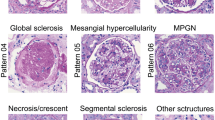Abstract
Considerable morphological phenotyping studies in nephrology have emerged in the past few years, aiming to discover hidden regularities between clinical and imaging phenotypes. Such studies have been largely enabled by deep learning based image analysis to extract sparsely located targeting objects (e.g., glomeruli) on high-resolution whole slide images (WSI). However, such methods need to be trained using labor-intensive high-quality annotations, ideally labeled by pathologists. Inspired by the recent “human-in-the-loop” strategy, we developed EasierPath, an open-source tool to integrate human physicians and deep learning algorithms for efficient large-scale pathological image quantification as a loop. Using EasierPath, physicians are able to (1) optimize the recall and precision of deep learning object detection outcomes adaptively, (2) seamlessly support deep learning outcomes refining using either our EasierPath or prevalent ImageScope software without changing physician’s user habit, and (3) manage and phenotype each object with user-defined classes. As a user case of EasierPath, we present the procedure of curating large-scale glomeruli in an efficient human-in-the-loop fashion (with two loops). From the experiments, the EasierPath saved 57% of the annotation efforts to curate 8,833 glomeruli during the second loop. Meanwhile, the average precision of glomerular detection was leveraged from 0.504 to 0.620. The EasierPath software has been released as open-source to enable the large-scale glomerular prototyping. The code can be found in https://github.com/yuankaihuo/EasierPath.
Access this chapter
Tax calculation will be finalised at checkout
Purchases are for personal use only
Similar content being viewed by others
References
Gadermayr, M., Dombrowski, A.K., Klinkhammer, B.M., Boor, P., Merhof, D.: CNN cascades for segmenting sparse objects in gigapixel whole slide images. Comput. Med. Imaging Graph. 71, 40–48 (2019)
Gadermayr, M., Klinkhammer, B.M., Boor, P., Merhof, D.: Do we need large annotated training data for detection applications in biomedical imaging? A case study in renal glomeruli detection. In: Wang, L., Adeli, E., Wang, Q., Shi, Y., Suk, H.-I. (eds.) MLMI 2016. LNCS, vol. 10019, pp. 18–26. Springer, Cham (2016). https://doi.org/10.1007/978-3-319-47157-0_3
Ginley, B., Tomaszewski, J.E., Yacoub, R., Chen, F., Sarder, P.: Unsupervised labeling of glomerular boundaries using Gabor filters and statistical testing in renal histology. J. Med. Imaging 4(2), 021102 (2017)
Ginley, B.G., Tomaszewski, J.E., Jen, K.Y., Fogo, A., Jain, S., Sarder, P.: Computational analysis of the structural progression of human glomeruli in diabetic nephropathy. In: Medical Imaging 2018: Digital Pathology, vol. 10581, p. 105810A. International Society for Optics and Photonics (2018)
Grimm, P.C., et al.: Computerized image analysis of Sirius red-stained renal allograft biopsies as a surrogate marker to predict long-term allograft function. J. Am. Soc. Nephrol. 14(6), 1662–1668 (2003)
Hermsen, M.: Deep learning-based histopathologic assessment of kidney tissue. J. Am. Soc. Nephrol. 30(10), 1968–1979 (2019)
Kato, T., et al.: Segmental hog: new descriptor for glomerulus detection in kidney microscopy image. BMC Bioinform. 16(1), 316 (2015)
Klapczynski, M., Gagne, G.D., Morgan, S.J., Larson, K.J., LeRoy, B.E., Blomme, E.A., et al.: Computer-assisted imaging algorithms facilitate histomorphometric quantification of kidney damage in rodent renal failure models. J. Pathol. Inform. 3, 20 (2012)
Litjens, G., et al.: A survey on deep learning in medical image analysis. Med. Image Anal. 42, 60–88 (2017)
Litjens, G., et al.: Deep learning as a tool for increased accuracy and efficiency of histopathological diagnosis. Sci. Rep. 6, 26286 (2016)
Lutnick, B., et al.: An integrated iterative annotation technique for easing neural network training in medical image analysis. Nature Mach. Intell. 1(2), 112–119 (2019)
Murray, M.E., Graff-Radford, N.R., Ross, O.A., Petersen, R.C., Duara, R., Dickson, D.W.: Neuropathologically defined subtypes of Alzheimer’s disease with distinct clinical characteristics: a retrospective study. Lancet Neurol. 10(9), 785–796 (2011)
Ozenne, B., Subtil, F., Maucort-Boulch, D.: The precision-recall curve overcame the optimism of the receiver operating characteristic curve in rare diseases. J. Clin. Epidemiol. 68(8), 855–859 (2015)
Servais, A., et al.: Interstitial fibrosis evolution on early sequential screening renal allograft biopsies using quantitative image analysis. Am. J. Transplant. 11(7), 1456–1463 (2011)
Wang, Y., et al.: Weakly supervised universal fracture detection in pelvic x-rays. In: Shen, D., et al. (eds.) MICCAI 2019. LNCS, vol. 11769, pp. 459–467. Springer, Cham (2019). https://doi.org/10.1007/978-3-030-32226-7_51
Yang, H., et al.: CircleNet: anchor-free detection with circle representation. arXiv preprint arXiv:2006.02474 (2020)
Acknowledgments
This work was supported by NIH NIDDK DK56942(ABF).
Author information
Authors and Affiliations
Corresponding author
Editor information
Editors and Affiliations
Rights and permissions
Copyright information
© 2020 Springer Nature Switzerland AG
About this paper
Cite this paper
Zhu, Z., Lu, Y., Deng, R., Yang, H., Fogo, A.B., Huo, Y. (2020). EasierPath: An Open-Source Tool for Human-in-the-Loop Deep Learning of Renal Pathology. In: Cardoso, J., et al. Interpretable and Annotation-Efficient Learning for Medical Image Computing. IMIMIC MIL3ID LABELS 2020 2020 2020. Lecture Notes in Computer Science(), vol 12446. Springer, Cham. https://doi.org/10.1007/978-3-030-61166-8_23
Download citation
DOI: https://doi.org/10.1007/978-3-030-61166-8_23
Published:
Publisher Name: Springer, Cham
Print ISBN: 978-3-030-61165-1
Online ISBN: 978-3-030-61166-8
eBook Packages: Computer ScienceComputer Science (R0)





